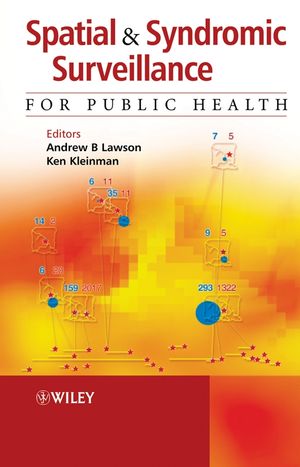Spatial and Syndromic Surveillance for Public HealthISBN: 978-0-470-09248-4
Hardcover
272 pages
May 2005
 This is a Print-on-Demand title. It will be printed specifically to fill your order. Please allow an additional 10-15 days delivery time. The book is not returnable.
|
||||||
List of Contributors.
1 Introduction: Spatial and syndromic surveillance for public health (Andrew B. Lawson and Ken Kleinman).
1.1 What is public health surveillance?
1.2 The increased importance of public health surveillance.
1.3 Geographic information, cluster detection and spatial surveillance.
1.4 Surveillance and screening.
1.5 Overview of process control and mapping.
1.6 The purpose of this book.
1.7 The contents of this book.
Part I: Introduction to Temporal Surveillance.
2 Overview of temporal surveillance (Yann Le Strat).
2.1 Introduction.
2.2 Statistical methods.
2.3 Conclusion.
3 Optimal surveillance (Marianne Frisén and Christian Sonesson).
3.1 Introduction.
3.2 Optimality for a fixed sample and for on-line surveillance.
3.3 Specification of the statistical surveillance problem.
3.4 Evaluations of systems for surveillance.
3.5 Optimality criteria.
3.6.1 The likelihood ratio method.
3.7 Special aspects of optimality for surveillance of public health.
3.8 Concluding remarks.
Acknowledgment.
Part II: Basic Methods for Spatial and Syndromic Surveillance.
4 Spatial and spatio-temporal disease analysis (Andrew B. Lawson).
4.1 Introduction.
4.2 Disease mapping and map reconstruction.
4.3 Disease map restoration.
4.4 Residuals and goodness of fit.
4.5 Spatio-temporal analysis.
4.6 Surveillance issues.
5 Generalized linear models and generalized linear mixed models for small-area surveillance (Ken Kleinman).
5.1 Introduction.
5.2 Surveillance using small-area modeling.
5.3 Alternate model formulations.
5.4 Practical variations.
5.5 Data.
5.6 Evaluation.
5.7 Conclusion.
6 Spatial surveillance and cumulative sum methods (Peter A. Rogerson).
6.1 Introduction.
6.2 Statistical process control.
6.3 Cumulative sum methods for spatial surveillance.
6.4 Summary and discussion.
Acknowledgments.
Appendix.
7 Scan statistics for geographical disease surveillance: an overview (Martin Kulldorff).
7.1 Introduction.
7.2 Scan statistics for geographical disease surveillance.
7.3 Secondary clusters.
7.4 Null and alternative hypotheses.
7.5 Power.
7.6 Visualizing the detected clusters.
7.7 A Sample of applications.
7.8 Software.
Acknowledgment.
8 Distance-based methods for spatial and spatio-temporal surveillance (Laura Forsberg, Marco Bonetti, Caroline Jeffery, Al Ozonoff and Marcello Pagano).
8.1 Introduction.
8.2 Motivation.
8.3 Distance-based statistics for surveillance.
8.4 Spatio-temporal surveillance: an example.
8.5 Locating clusters.
8.6 Conclusion.
Acknowledgments.
9 Multivariate surveillance (Christian Sonesson and Marianne Frisén).
9.1 Introduction.
9.2 Specifications.
9.3 Approaches to multivariate surveillance.
9.4 Evaluation of the properties of multivariate surveillance methods.
9.5 Concluding discussion.
Part III: Database Mining and Bayesian Methods.
10 Bayesian network approaches to detection (Weng-Keen Wong and Andrew W. Moore).
10.1 Introduction.
10.2 Association rules.
10.3 WSARE.
10.4 Evaluation.
10.5 Results.
10.6 Conclusion.
11 Efficient scan statistic computations (Daniel B. Neill and Andrew W. Moore)
11.1 Introduction.
11.2 Overlap-multiresolution partitioning.
11.3 Results.
11.4 Conclusions and future work.
12 Bayesian data mining for health surveillance (David Madigan).
12.1 Introduction.
12.2 Probabilistic graphical models.
12.3 Hidden Markov models for surveillance: illustrative examples.
12.4 Hidden Markov models for surveillance: further exploration.
12.5 Random observation time hidden Markov models.
12.6 Interpretation of hidden Markov models for surveillance.
12.7 Discussion.
Acknowledgments.
13 Advanced modeling for surveillance: clustering of relative risk changes (Andrew B. Lawson).
13.1 Introduction.
13.2 Cluster concepts.
13.3 Cluster modeling.
13.4 Syndromic cluster assessment.
13.5 Bayesian version of the optimal surveillance alarm function.
13.6 Computational issues.
13.7 Conclusions and future directions.
References.
Index.



